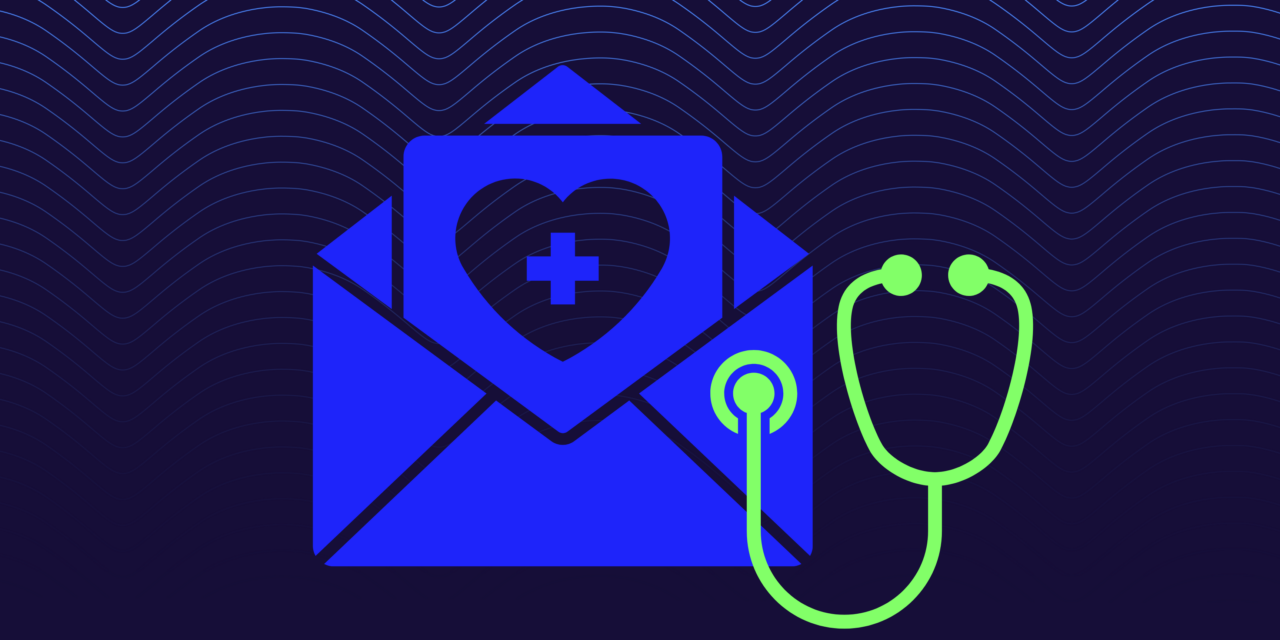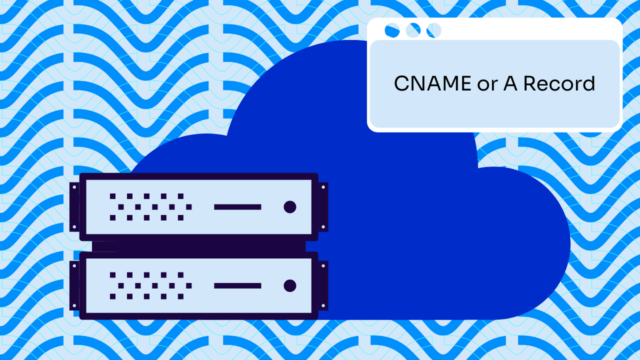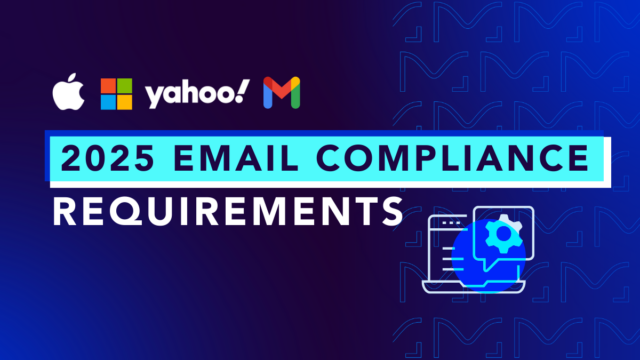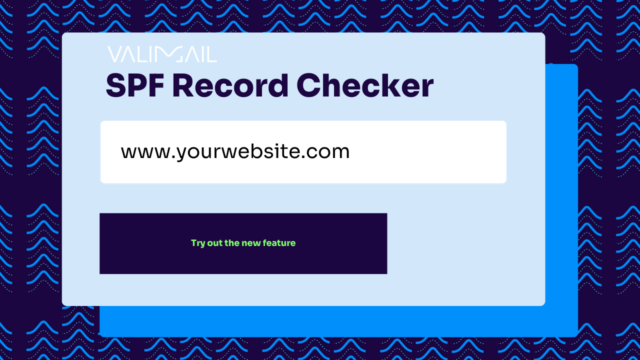Email is the lifeblood of communication in healthcare. From coordinating patient care to managing administrative tasks, it’s the go-to channel for exchanging information. But with the rise of cyber threats, securing these communications is more critical (and challenging) than ever.
Imagine: A major hospital network falls victim to a sophisticated phishing attack. The attackers, posing as trusted administrators, send fraudulent emails that trick staff into sharing sensitive patient information. The result? A massive data breach, millions of dollars in fines, and an irreparable hit to the hospital’s reputation. Unfortunately, this scenario isn’t far-fetched. Healthcare organizations are prime targets for email spoofing and phishing attacks.
That’s where Domain-based Message Authentication, Reporting, and Conformance (DMARC) comes into play. DMARC helps protect against email spoofing and phishing, safeguarding both patient data and organizational integrity.
Below, we’ll explain how DMARC can secure your healthcare organization’s email program and provide steps to get started.
DMARC’s role in healthcare email security
DMARC, or Domain-based Message Authentication, Reporting, and Conformance, is like the world’s most effective (and polite) bouncer for your email domain. It doesn’t just check IDs—it verifies credentials, checks the guest list, and even calls the host to make sure everything’s legitimate.
In healthcare terms, DMARC is the difference between running an open clinic where anyone can walk in claiming to be a doctor, and a secure facility where every person’s credentials are thoroughly checked at the door.
Here’s how DMARC protects your email system:
- Authentication: DMARC works with two other protocols—Sender Policy Framework (SPF) and DomainKeys Identified Mail (DKIM)—to create a triple-layered shield for your email domain.
- Impersonation defense: DMARC stops phishing emails pretending to come from your organization. It guarantees that only authorized senders can use your domain, making it nearly impossible for scammers to impersonate your organization.
- Visibility: DMARC doesn’t just protect—it informs. It provides detailed reports on email traffic, attempted fraud, and potential vulnerabilities.
- Flexibility: Healthcare organizations often have complex email setups with multiple departments, third-party vendors, and external partners. DMARC is flexible enough to accommodate this complexity while still maintaining reliable security.
Unsure of where your healthcare organization’s DMARC stands? Use our free domain checker to get started.
Why DMARC is non-negotiable for healthcare organizations
In an industry where a single leaked patient record can lead to massive fines and irreparable damage, DMARC isn’t just helpful—it’s essential. Here’s why:
- HIPAA compliance: While DMARC isn’t explicitly required by HIPAA, it’s a powerful tool in your compliance arsenal. It helps prevent unauthorized access to Protected Health Information (PHI) via email, a key requirement of the HIPAA Security Rule. Valimail’s solutions don’t store your data, meaning there is no risk to PII.
- Phishing prevention: Healthcare is the #1 target for phishing attacks. DMARC is your first line of defense, dramatically reducing the chances of a successful phishing attempt.
- Brand protection: Your reputation is everything in healthcare. DMARC guarantees that when patients see an email from your domain, they can trust it’s really from you.
- Improved email deliverability: Ever wonder why some of your important emails end up in spam folders? DMARC can help prevent that and get your critical communications to intended recipients.
- Google and Yahoo compliance: In 2023, Google and Yahoo announced email authentication requirements for bulk senders that send more than 5,000 emails a day. If you send over this limit, you need to implement DMARC as soon as possible to ensure your email gets delivered.
The real cost of email fraud in healthcare
When we talk about email fraud in healthcare, we’re not just discussing a minor inconvenience – we’re looking at a potential catastrophe that can shake a healthcare organization to its core. Let’s break down the real, often underestimated costs of email fraud in the medical sector.
Financial impacts: the silent budget killer
First up, let’s talk money—because in healthcare, every dollar counts. Email fraud can be a financial black hole, sucking in resources faster than you can say “phishing attack.”
Direct losses from email fraud can be staggering. Imagine a scenario where a cybercriminal, posing as a trusted vendor, convinces your accounts payable department to wire a six-figure sum for “updated medical equipment.” By the time the fraud is discovered, that money is long gone, potentially affecting your ability to upgrade actual necessary equipment or even meet payroll.
But the bleeding doesn’t stop there. Recovery costs can dwarf the initial loss. You’re looking at expenses for:
- Forensic investigations to understand the breach
- IT overtime to patch vulnerabilities
- Legal fees for potential lawsuits
- Crisis management and PR services
- Patient notification costs
- Credit monitoring services for affected individuals
These costs can quickly spiral into millions, turning what seemed like a “simple” email scam into a financial nightmare that impacts patient care and organizational growth.
Reputational damage: trust is hard to earn, easy to lose
In healthcare, reputation isn’t just about brand image—it’s about trust. Patients entrust you with their most sensitive information and (quite literally) their lives. An email fraud incident can shatter this trust overnight. In fact, around 90% of healthcare organizations have experienced at least one data breach within the last two years.
Imagine the local news headline: “City Hospital Falls Victim to Email Scam, Patient Data at Risk.” Suddenly, potential patients are second-guessing their choice of healthcare provider. Existing patients may start looking elsewhere, fearing their personal information isn’t safe with you.
This loss of trust doesn’t just affect patient numbers. It can impact:
- Physician recruitment and retention (top talent may hesitate to join a “compromised” organization)
- Partnerships with other healthcare providers
- Relationships with insurance companies
- Community support and donations for non-profit healthcare organizations
Rebuilding this trust isn’t just costly—it’s time-consuming. And in healthcare, time equals lives.
Regulatory fines and penalties: the hammer of compliance
As if the financial losses and reputational damage weren’t enough, healthcare organizations face a unique threat: regulatory penalties. The healthcare industry is one of the most heavily regulated when it comes to data protection, and for good reason.
An email fraud incident that leads to a data breach can put you in the crosshairs of multiple regulatory bodies:
- HIPAA violations can result in fines of up to $1.5 million per year for each violation category
- The HITECH Act can impose penalties of up to $1.5 million per violation
- State-specific regulations may impose additional fines
- The FTC can levy penalties for failing to protect consumer data
These fines aren’t just slaps on the wrist—they can be organization-killers, especially for smaller clinics or hospitals already operating on thin margins. Plus, regulatory violations often come with mandatory corrective action plans. These plans can be costly and resource-intensive to implement, further straining your already stretched budget and staff.
Challenges of implementing DMARC in healthcare
DMARC isn’t rocket science or brain surgery, but sometimes it can feel downright close. It’s absolutely necessary and potentially life-saving (for your organization, at least), but it comes with its own set of challenges. Let’s take a look at some of those obstacles:
1. Legacy systems
Many healthcare organizations rely on older technology that’s been in place for years, making them an even bigger risk for spoofing and phishing. However, this outdated tech can also make it more challenging to implement DMARC.
Challenge: Integrating DMARC with systems that weren’t designed with modern email authentication in mind.
Solution: Start by identifying which systems need updates or replacements. For those that can’t be immediately upgraded, look for interim solutions that bridge old and new technologies. Gradual progress is still progress. If you don’t have time to update your outdated tech, reach out to a trusted DMARC vendor, like Valimail, who can quickly implement and manage your DMARC regardless of your current tech stack.
2. Third-party integrations
Healthcare organizations often work with several external partners who send emails on their behalf.
Challenge: Aligning all these partners with your DMARC policy without disrupting important communications.
Solution: Establish clear communication channels with your partners. Provide them with straightforward guidelines and support. Consider implementing DMARC in phases to minimize disruptions.
3. Time and money
Most healthcare IT teams already have too much on their plate.
Challenge: Finding the time, expertise, and budget to implement and maintain DMARC effectively.
Solution: Present DMARC as an investment in your organization’s security. Consider bringing in a DMARC provider like Valimail to help with implementation. Remember, the cost of implementing DMARC is often much less than dealing with a major security breach.
4. Policy hesitations
DMARC offers various policy options, from monitoring to rejecting non-compliant emails.
Challenge: Implementing a policy that’s strict enough to be effective without disrupting legitimate email flow.
Solution: Begin with a monitoring policy. Gradually increase the strictness as you become more confident in your setup.

5. Managing multiple subdomains
Large healthcare organizations often have numerous subdomains.
Challenge: Identifying all subdomains and implementing DMARC consistently across them.
Solution: Conduct a comprehensive domain audit. Create a systematic plan to implement DMARC across all subdomains, prioritizing those handling sensitive information. If you’re struggling to identify all your subdomains and sending services, Valimail can easily identify your services by name rather than by IP address. Start getting free visibility into your domain with Valimail Monitor.
How to implement DMARC for healthcare organizations
Depending on how large your healthcare organization is, it could take months or even years to fully get to DMARC enforcement on your own. You’ll have to:
- Assess your current email infrastructure
- Implement SPF
- Implement DKIM
- Create a DMARC record
- Publish your DMARC record
- Monitor and analyze your domain
- Remediate any issues
- Gradually increase DMARC policy strictness
- Implement DMARC on all your subdomains
- Establish ongoing monitoring and maintenance
- Train staff and update procedures
What if there was an easier way to manage it? Let Valimail be the “easy button” for your DMARC management. We’ve gotten some healthcare companies, like MVP Health Care, to DMARC enforcement in just 47 business days. In general, Valimail gets you to DMARC enforcement 4x faster than other vendors and 8x faster than doing it on your own.

“Valimail support was incredible during implementation and during the course of our subscription with them. They walked me through every step in setting up our DNS and M365. It took a while to get to the “Reject” stage of non-legit emails (it’s to be expected if you want to capture everything you can) but even at the “Quarantine” stage Valimail was blocking over 90% of all emails coming into our email server and they were all Spam or Malicious emails. We rarely received any Spam after that! Truely a must have for every business using email.”
Verified User in Hospital & Health Care, G2
DMARC best practices for securing patients and data
Implementing DMARC in healthcare requires a careful approach to protect sensitive patient information and maintain compliance with regulations. Here are some best practices to improve your DMARC implementation:
Implement DMARC policies gradually and wisely
When it comes to enforcing DMARC policies, slow and steady wins the race (unless you’re working with an expert DMARC vendor like Valimail). Start with p=none—it’s like putting your policy in observation mode. Then, move to p=quarantine, starting with a small percentage of emails and gradually increasing.
Only switch to p=reject when you’re absolutely sure everything’s working smoothly. It’s like gradually introducing a new procedure in your practice—you want to make sure everything’s perfect before going all in.

Tailor your approach for different domains
Remember, one size doesn’t fit all in healthcare, and the same goes for your email domains. Your domain handling sensitive patient data might need stricter policies compared to your marketing domain. It’s like having different security levels for different hospital areas—the ICU needs tighter controls than the gift shop, right?
Let DMARC reports be your guide
Don’t overlook those DMARC reports—they’re goldmines of information. Set up systems to collect and analyze them regularly. Use what you learn to fine-tune your email security.
“Vailmail is a great solution to visualize the statistics of emails going through DMARC. It enbaled us to see what is being caught up in DMARC whether that be malicious impersonation attempts or legitamate services and allows us to make those changes to the DNS record.”
Verified User in Mental Health Care, G2
Integrate DMARC into your overall security strategy
DMARC works best when it’s part of a larger security strategy. Pair it with email encryption for sensitive communications. Consider implementing BIMI for that extra visual trust factor. DMARC alone is good, but DMARC, as part of a comprehensive approach, is even better.
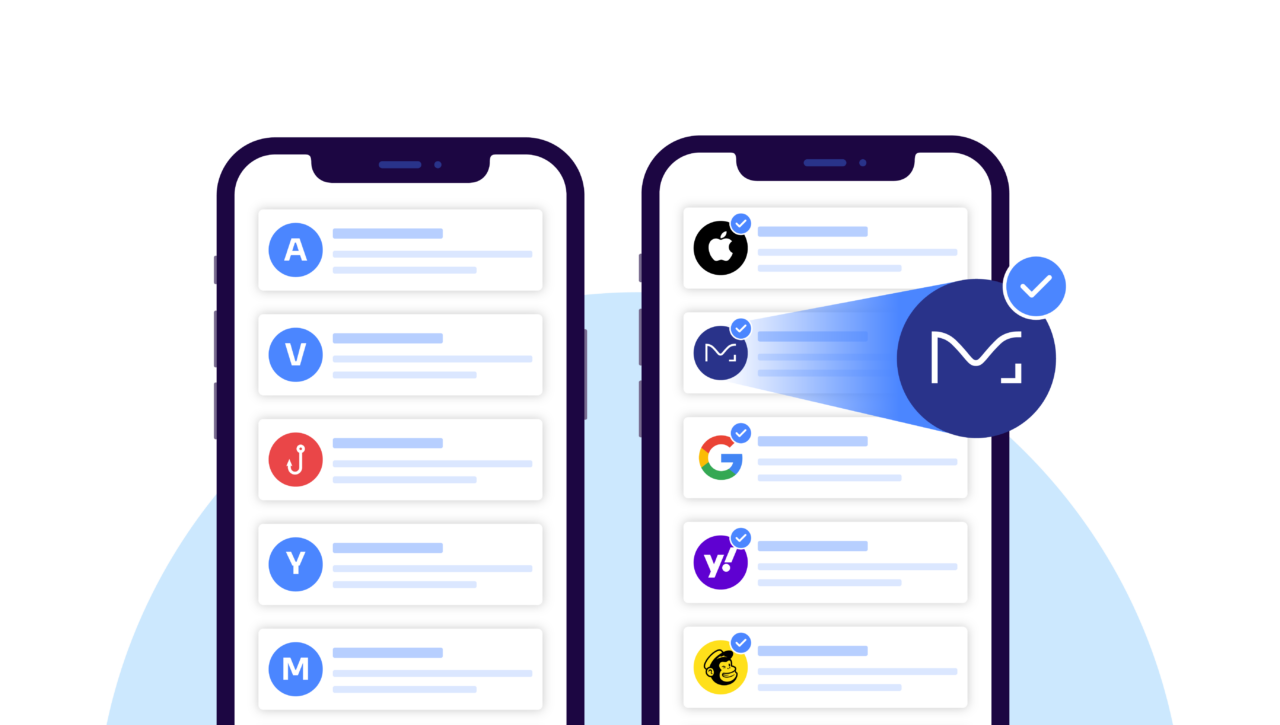
Keep an eye out for domain abuse
Stay vigilant about any misuse of your domain. Use those DMARC reports to spot attempted spoofing. Have a process ready to address any abuse quickly. Think of it as your early warning system for email-related health issues.
Protect your healthcare organization with Valimail
Implementing DMARC to secure your healthcare organization’s email system is essential to safeguarding your business, but that’s easier said than done. Fortunately, we can help.
Valimail isn’t just another tech company—we’re your partners in email authentication. Our automated DMARC solution takes the guesswork out of email authentication, allowing you to focus on what you do best—providing top-notch patient care. We work with some of the top healthcare companies, like Northwestern Medicine, UF Health, AdventHealth, and Indiana University Health.
With Valimail, you get:
- A solution designed with healthcare compliance in mind
- Automated implementation that won’t strain your already-busy IT team
- Real-time monitoring and alerts to catch potential threats before they become problems
- Exceptional support from a team that understands the healthcare landscape
We know you’re juggling a million things already. That’s why we’ve made our DMARC implementation process as smooth as possible. No need to become an overnight email authentication expert—we’ve got you covered.
See it for yourself! Learn how we can protect your healthcare organization:
